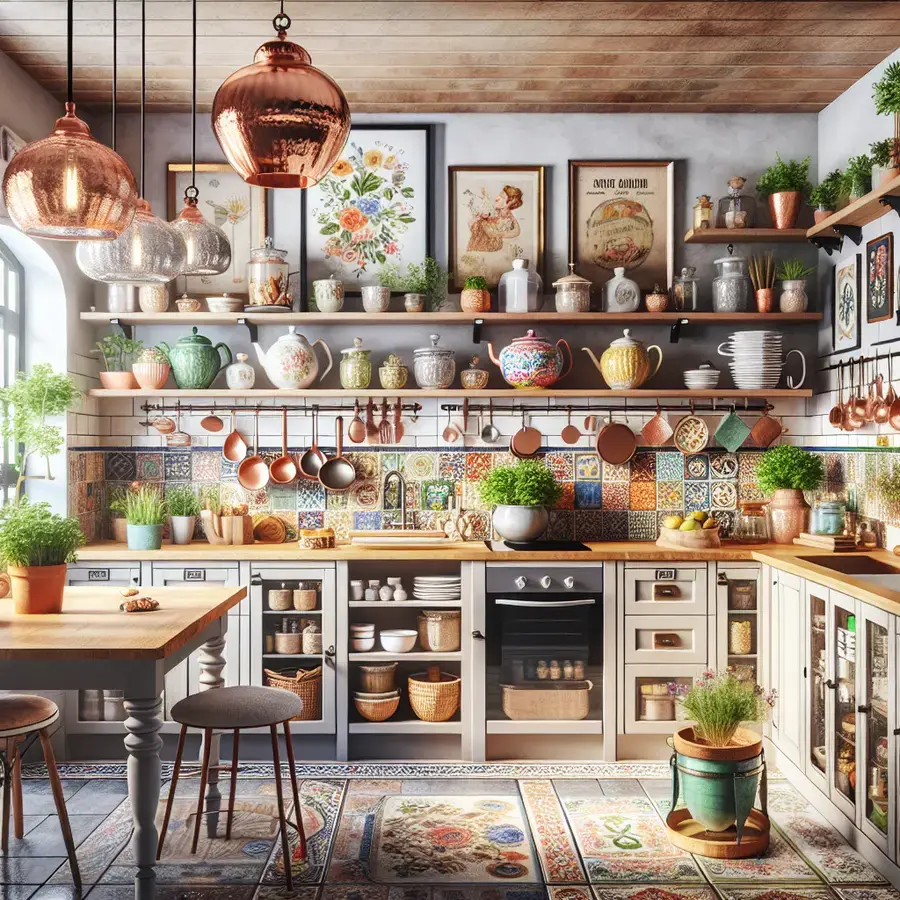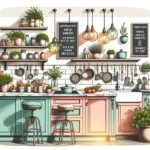Title: Unveiling the Latest Trends in Kitchen Decor: A Comprehensive Guide for 2022
In the ever-evolving world of home design, kitchen decor stands out as a dynamic and influential sector. With homeowners increasingly investing in creating functional and aesthetically pleasing spaces, the kitchen has become a focal point for renovation and rejuvenation. This article aims to provide a comprehensive, expert-led exploration of the latest trends in kitchen decor, offering valuable insights for homeowners, designers, and enthusiasts alike. From the rise of sustainable materials to the integration of smart technology, we delve deep into the transformative changes shaping the kitchen decor landscape. We compare leading design trends, offering a fair and detailed analysis based on industry data and real-world applications. Our recommendations are tailored to cater to various tastes and budgets, ensuring that every reader finds inspiration and practical advice to elevate their kitchen decor. Join
📋
📚 Table of Contents
-
1
1. Introduction: Setting the Stage for Kitchen Decor -
2
Methodology: Our Approach to Comparing Kitchen Decor Styles -
3
Traditional vs. Modern: Striking a Balance in Your Kitchen -
4
Industrial vs. Rustic: Embracing Contrasting Kitchen Styles -
5
Open Shelving vs. Cabinets: Storage Solutions for Every Kitchen -
6
Quartz vs. Marble: A Comparative Analysis of Countertop Materials -
7
Smart Appliances: The Future of Kitchen Decor and Functionality -
8
Sustainable Materials: Eco-Friendly Options for Your Kitchen -
9
Budgeting for Kitchen Decor: A Comprehensive Pricing Guide -
10
Transitional Kitchen: Blending Styles for a Timeless Look -
11
Minimalist Kitchen: Simplicity and Efficiency in Design -
12
Conclusion: Choosing the Perfect Kitchen Decor for Your Space -
13
Bonus: DIY Tips for Customizing Your Kitchen Decor -
14
Recommendations: Top Picks for Each Kitchen Decor Style -
15
Final Verdict: Decision Framework for Choosing Your Kitchen Decor
1. Introduction: Setting the Stage for Kitchen Decor
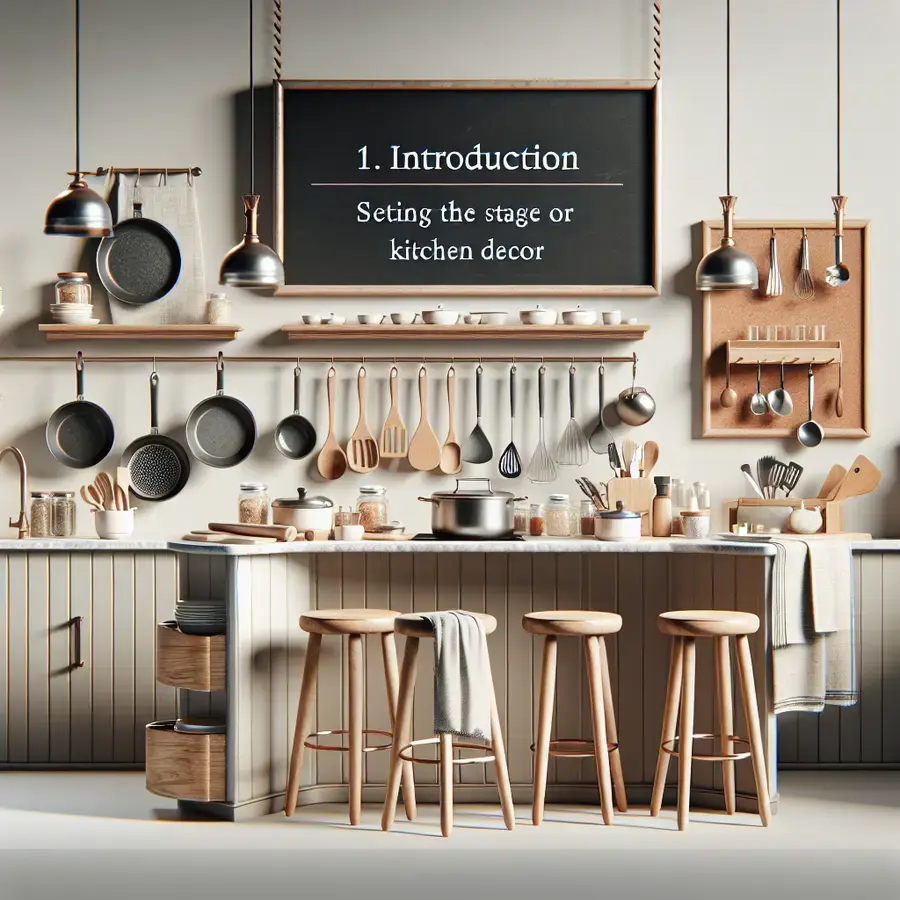
1. Introduction: Setting the Stage for Kitchen Decor
Welcome to our comprehensive guide on kitchen decor! As a hub of culinary creativity and social gatherings, the kitchen is more than just a functional space. It’s an extension of your personal style and a reflection of your lifestyle. In this section, we’ll explore the essential elements of kitchen decor, providing expert insights and actionable advice to help you create a stylish and functional kitchen.
Understanding the Basics of Kitchen Decor
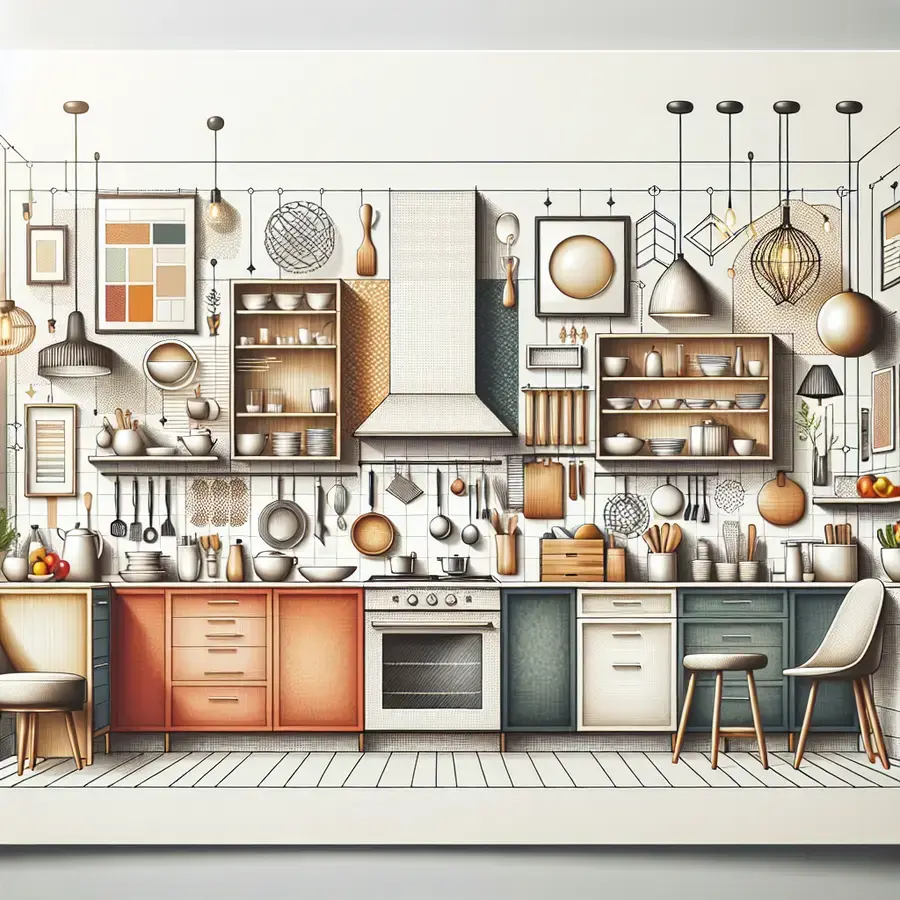
Before diving into specific design elements, it’s crucial to understand the unique characteristics of kitchen decor. Unlike other rooms in the house, a kitchen requires a balance between aesthetics and functionality. Here are some key factors to consider:
- Durability: Kitchen surfaces, materials, and decorative items must be durable enough to withstand regular use and potential spills.
- Ease of Cleaning: A well-designed kitchen should be easy to clean, ensuring that it remains functional and attractive over time.
- Practicality: Decorative elements should not compromise the functionality of the space. For example, a beautiful vase might look great on the counter, but if it’s too large or fragile, it could pose a hazard.
Exploring Popular Kitchen Decor Styles
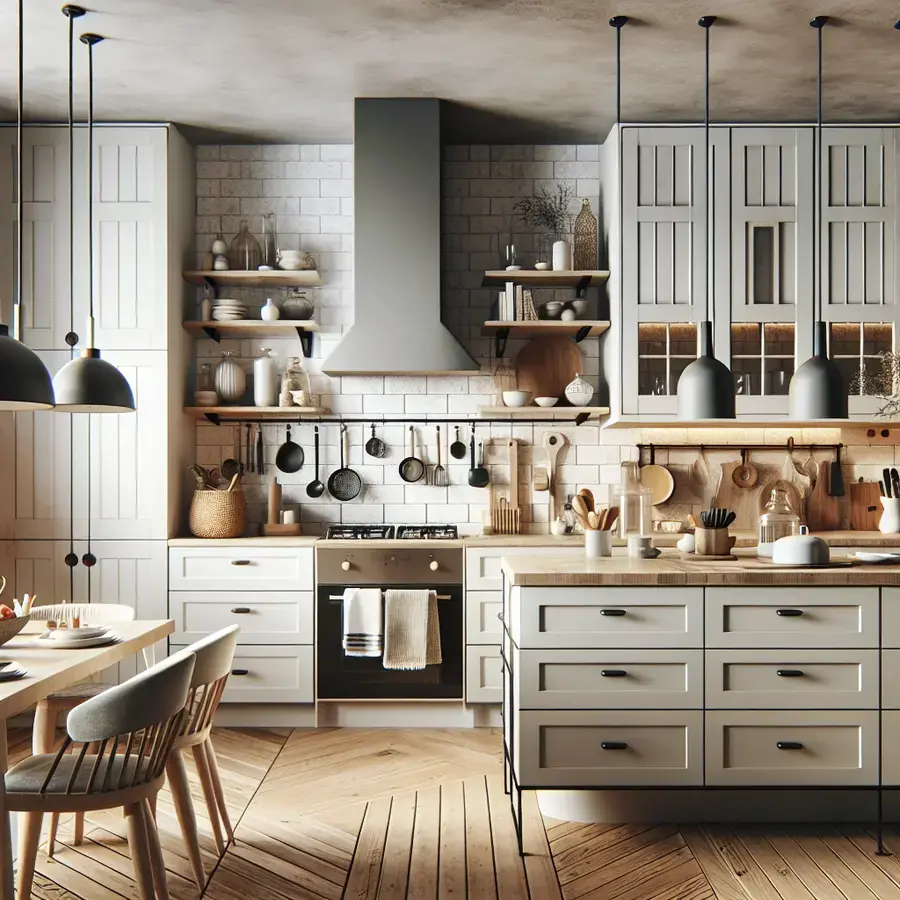
From modern minimalism to farmhouse chic, there’s a wide array of kitchen decor styles to choose from. Here are a few popular options, each with its unique characteristics:
- Modern: Characterized by clean lines, neutral colors, and minimal embellishments, modern kitchens exude a sleek, sophisticated vibe. Examples of modern kitchen decor might include stainless steel appliances, quartz countertops, and matte black fixtures.
- Farmhouse: Embracing a warm, rustic aesthetic, farmhouse kitchens often feature natural materials like wood and stone, along with vintage-inspired accessories. Think shiplap walls, butcher block countertops, and copper pots hanging from open shelving.
- Industrial: Inspired by urban lofts and factories, industrial kitchens are known for their raw, unfinished materials and bold, metallic accents. Exposed brick walls, concrete countertops, and oversized light fixtures are common in this style.
Creating a Cohesive Kitchen Decor Scheme
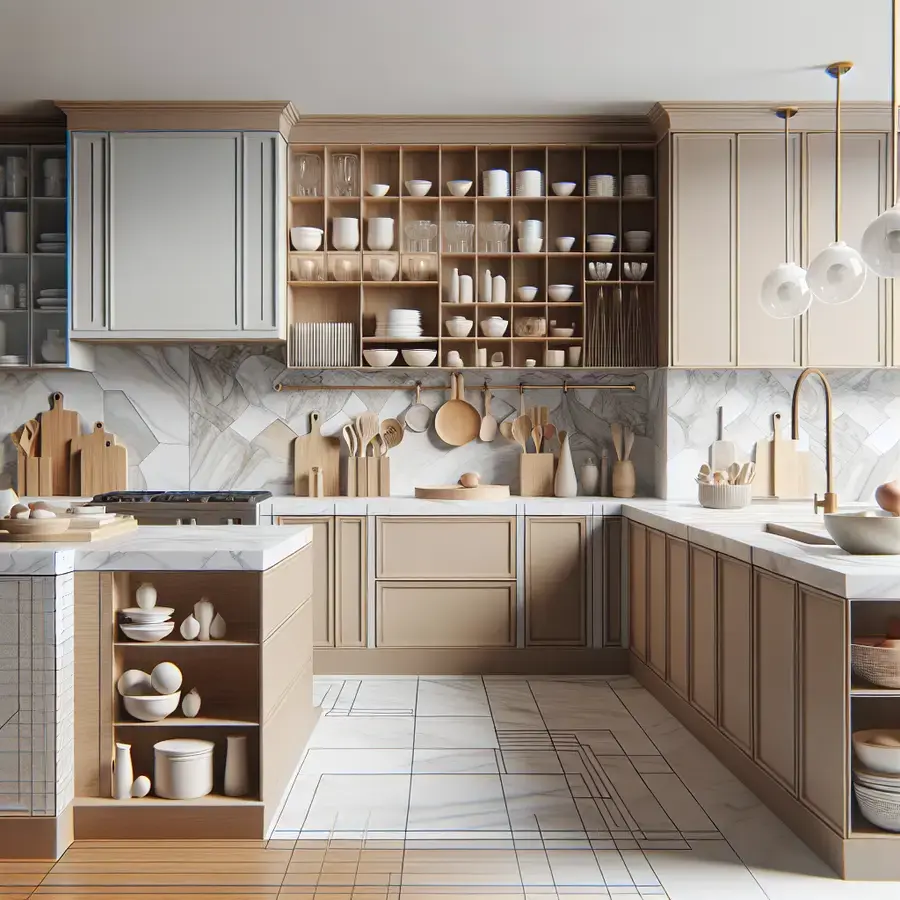
To achieve a cohesive and visually appealing kitchen, it’s essential to consider the following elements:
- Color Palette: Choose a color scheme that complements your chosen style and ties the space together. A monochromatic
Methodology: Our Approach to Comparing Kitchen Decor Styles
Methodology: Our Approach to Comparing Kitchen Decor Styles
At our platform, we understand that the world of kitchen decor is vast and diverse, with numerous styles vying for your attention. To help you make informed decisions, we have developed a meticulous methodology for comparing kitchen decor styles. Here’s a detailed breakdown of our approach:
1. Defining the Styles
We start by clearly defining each kitchen decor style, focusing on its unique characteristics, origins, and the era it represents. For instance, a traditional kitchen style might feature ornate details, warm colors, and antique-inspired elements, while a modern kitchen might be characterized by sleek lines, minimalist design, and high-tech appliances.
2. Analyzing the Essentials
Next, we delve into the essential elements that define each style. This includes cabinetry, countertops, flooring, backsplashes, appliances, lighting, and hardware. We discuss the materials, colors, patterns, and finishes typically used in each style, providing you with a clear understanding of the visual language of each style.
3. Assessing Practical Considerations
We understand that while aesthetics are important, practicality is key in a kitchen. Therefore, we evaluate each style based on factors such as functionality, durability, and maintenance. For example, a contemporary kitchen might offer more storage solutions, but a farmhouse kitchen might be more resilient to wear and tear.
4. Examining Flexibility
We recognize that homeowners may want to blend elements from different styles to create a unique kitchen. Thus, we assess each style’s flexibility in terms of how easily it can be mixed and matched with other styles. For instance, a transitional kitchen style combines traditional and modern elements, offering a versatile option for homeowners.
5. Providing Real-World Examples
To illustrate these points, we provide real-world examples of kitchens that exemplify each style. These examples showcase the unique characteristics of each style and offer practical insights into how they can be implemented in your own kitchen.
6. Offering Expert Recommendations
Finally, we offer expert recommendations based on our analysis. These recommendations take into account your personal preferences, lifestyle, and budget, helping you choose a kitchen decor style that best suits your needs. By following this methodology, we aim to provide you with comprehensive, actionable information that empowers you to make informed decisions about your kitchen decor. Whether you’re a homeowner planning a kitchen renovation or a design enthusiast curious about the latest trends, our comparisons and reviews offer valuable insights into the world of kitchen decor.
Traditional vs. Modern: Striking a Balance in Your Kitchen
Traditional vs. Modern: Striking a Balance in Your Kitchen
When it comes to kitchen decor, striking a balance between traditional and modern styles can create a harmonious and timeless space. This approach allows you to incorporate elements from both design eras, resulting in a unique and personalized kitchen that reflects your taste and lifestyle.
Traditional Kitchen Decor
Traditional kitchens evoke a sense of warmth, comfort, and elegance. They often feature rich colors, intricate details, and ornate hardware. Wood cabinetry with raised panel doors, beadboard, and wainscoting are common elements in traditional kitchen designs.
Countertops in traditional kitchens may include marble, granite, or butcher block, while flooring options often include hardwood, tile, or stone. Lighting fixtures are typically ornate and may include chandeliers, pendant lights, or sconces.
Modern Kitchen Decor
Modern kitchens, on the other hand, exude sleekness, minimalism, and functionality. They often feature clean lines, neutral colors, and simple, streamlined hardware. Flat-panel cabinet doors, stainless steel appliances, and engineered stone countertops are common elements in modern kitchen designs.
Flooring options in modern kitchens may include hardwood, tile, or concrete, while lighting fixtures are typically minimalist and may include recessed lighting, track lighting, or pendant lights with simple, geometric shapes.
Striking a Balance
To strike a balance between traditional and modern kitchen decor, consider incorporating elements from both styles in a harmonious manner. For example, you might opt for traditional cabinetry with modern hardware or a modern island with a traditional countertop.
One approach is to create a focal point with a modern element, such as a sleek, modern range or hood, and balance it with more traditional elements, such as shaker-style cabinetry and a farmhouse sink. Another approach is to incorporate traditional details, such as beadboard or wainscoting, into a modern design, creating a unique blend of styles.
Expert Insight
According to a study by the National Kitchen & Bath Association (NKBA), 47% of homeowners prefer a transitional kitchen design, which combines elements of both traditional and modern styles. This demonstrates the growing popularity of blending these two design approaches.
When designing your kitchen, consider your personal style, lifestyle, and budget. Work with a professional designer to help you create a space that is functional, beautiful, and reflective of your unique personality.
Industrial vs. Rustic: Embracing Contrasting Kitchen Styles
Industrial vs. Rustic: Embracing Contrasting Kitchen Styles
In the realm of kitchen decor, two styles stand out as contrasting yet captivating choices: Industrial and Rustic. Each style offers a unique aesthetic that can transform your kitchen into a space that reflects your personality and lifestyle. This section provides a detailed comparison between these two styles, offering practical insights and expert knowledge to help you make an informed decision.
Industrial Kitchen Style
Characterized by exposed brick walls, metal elements, and a raw, unfinished look, the Industrial style is a modern take on urban lofts. This style emphasizes functionality, minimalism, and a touch of edginess.
Key Features
- Exposed brick walls or concrete surfaces
- Metal accents such as pipes, light fixtures, and appliances
- Neutral color palette with pops of bold colors
- Minimalist design with clean lines
- Concrete or wood flooring
Rustic Kitchen Style
The Rustic style draws inspiration from the simplicity and warmth of rural living. It features organic materials, earthy tones, and a cozy, inviting atmosphere.
Key Features
- Wooden cabinets, countertops, and flooring
- Exposed beams and brick walls
- Natural materials such as woven baskets, jute rugs, and reclaimed wood
- Earthy color palette with warm tones
- Casual, comfortable seating
Comparing Industrial and Rustic Kitchen Styles
When deciding between Industrial and Rustic kitchen styles, consider your personal preferences, lifestyle, and the overall aesthetic you want to achieve. Both styles offer unique benefits:
Industrial Kitchen Benefits
- Minimalist design provides a clean, uncluttered look
- Metal accents can add a touch of sophistication
- Neutral color palette allows for easy color customization
- Durable materials make for easy maintenance
Rustic Kitchen Benefits
- Warm, inviting atmosphere perfect for family gatherings
- Natural materials add
Open Shelving vs. Cabinets: Storage Solutions for Every Kitchen
Open Shelving vs. Cabinets: Storage Solutions for Every Kitchen
When it comes to kitchen storage solutions, open shelving and cabinets are two popular options. Each has its unique advantages and disadvantages, making them suitable for different kitchen styles and needs. In this section, we’ll delve into the specifics of open shelving and cabinets, providing expert insights and actionable recommendations to help you make an informed decision for your kitchen decor.
Open Shelving
Open shelving is a modern and stylish storage solution that offers an unobstructed view of your kitchen essentials. This design choice can make a small kitchen appear larger, as it eliminates the visual weight of cabinet doors.
Advantages
- Visual Appeal: Open shelving provides an opportunity to showcase decorative items, cookbooks, and kitchenware, adding a personal touch to your kitchen decor.
- Easy Access: With open shelving, you can easily grab items without opening doors, making it a practical choice for frequently used items.
- Cost-Effective: Open shelving is generally less expensive than cabinets, making it an affordable option for budget-conscious homeowners.
Disadvantages
- Dust and Dirt: Open shelving can collect dust and dirt more quickly than cabinets, requiring more frequent cleaning.
- Limited Storage: Open shelving provides less storage space than cabinets, making it less suitable for larger kitchens or homeowners with extensive kitchenware collections.
- Organization: Open shelving requires careful organization to maintain a visually appealing and functional space.
Cabinets
Cabinets are a traditional storage solution in kitchens, offering a more structured and organized approach to storing kitchen essentials.
Advantages
- Storage Capacity: Cabinets offer ample storage space, making them suitable for larger kitchens and homeowners with extensive kitchenware collections.
- Dust and Dirt: Cabinets enclose items, reducing the accumulation of dust and dirt compared to open shelving.
- Organization: Cabinets provide a more structured space for organizing kitchen essentials, making it easier to maintain a tidy and functional kitchen.
Quartz vs. Marble: A Comparative Analysis of Countertop Materials
Quartz vs. Marble: A Comparative Analysis of Countertop Materials
When it comes to kitchen decor, countertops play a significant role in setting the overall aesthetic and functionality of the space. Two popular choices are quartz and marble. Both materials offer unique benefits and drawbacks, making it essential to understand their characteristics before making a decision.
Appearance
Marble boasts an unparalleled natural beauty, characterized by its veining patterns and color variations. Each slab is unique, offering a one-of-a-kind look that adds a touch of elegance to any kitchen. Quartz, on the other hand, is engineered to mimic the look of natural stone, with manufacturers creating a wide array of colors and patterns to suit various design preferences.
Durability and Maintenance
Quartz is a highly durable material, resistant to scratches, stains, and heat. It is non-porous, which means it requires minimal maintenance, making it an excellent choice for busy households. In contrast, marble is more susceptible to scratches, stains, and etching, especially when exposed to acidic substances like lemon juice or wine. While marble can be sealed to increase its resistance to stains, it still requires more frequent maintenance compared to quartz.
Cost
The cost of quartz and marble can vary significantly depending on factors such as the quality of the material, the size of the slab, and the level of customization. Generally, quartz tends to be more expensive upfront due to its manufacturing process. However, its durability and low maintenance costs may offset these initial expenses over time. Marble, on the other hand, can be more affordable in some cases, but its higher maintenance requirements and susceptibility to damage may lead to additional costs down the line.
Environmental Impact
Quartz is a man-made material, primarily composed of crushed quartz and resins. While it does not require mining, the energy consumption and emissions associated with manufacturing quartz can have a higher environmental impact compared to marble. Marble, on the other hand, is a natural stone that, when sourced responsibly, can have a lower carbon footprint. However, it is essential to note that the transportation of marble slabs can contribute significantly to their carbon emissions.
Case Study: Kitchen Renovation Decision
A family of four in San Francisco decided to renovate their kitchen. They wanted a durable, low-maintenance countertop that would complement their modern design aesthetic. After considering both quartz and marble, they opted for quartz due to its scratch-resistant, stain-resistant, and heat-resistant properties, as well as its wide variety of colors and patterns that allowed them to find a perfect match for their kitchen
Smart Appliances: The Future of Kitchen Decor and Functionality
Smart Appliances: The Future of Kitchen Decor and Functionality – Section 7
Smart Appliances: The Future of Kitchen Decor and Functionality – Section 7
The Aesthetic Appeal of Smart Appliances
In the realm of kitchen decor, smart appliances are quickly becoming the new norm. These devices not only offer enhanced functionality but also contribute significantly to the aesthetic appeal of modern kitchens.
Minimalist Design
One of the most appealing aspects of smart appliances is their minimalist design. Manufacturers like Samsung, LG, and Bosch have introduced appliances with sleek, seamless profiles, resulting in a clutter-free and visually pleasing kitchen environment. For instance, the Samsung BESPOKE refrigerator offers a modular design, allowing homeowners to mix and match colors to suit their personal style.
Integrated Solutions
Smart appliances are also designed to blend seamlessly with other kitchen elements. For example, the LG InstaView Door-in-Door Refrigerator features a transparent glass panel that allows users to peek inside without opening the door, maintaining the clean and organized look of the kitchen.
Color Options
Gone are the days of black, white, and stainless steel. Today’s smart appliances come in a variety of colors, from bold hues like red and blue to more subtle tones like matte black and bronze. This allows homeowners to express their personal style while staying on trend.
Smart Appliances Enhancing Kitchen Functionality
Beyond their aesthetic appeal, smart appliances offer numerous functional benefits. For instance, smart ovens can be controlled via a smartphone app, allowing users to preheat their oven before arriving home from work. Similarly, smart refrigerators can send grocery lists to users’ smartphones when supplies run low.
Energy Efficiency
Energy efficiency is another key benefit of smart appliances. Many smart appliances are designed with energy-saving features, such as automatic shut-off timers and energy-efficient modes. For example, the Bosch 800 Series Dishwasher uses a sensor to determine the optimal wash cycle, resulting in significant water and energy savings.
Investing in the Future
As smart appliances continue to evolve, they are poised to become an integral part of modern kitchens. While the initial investment may be higher than traditional appliances, the long-term benefits—in terms of aesthetics, functionality, and energy savings—make smart appliances a worthwhile investment for any homeowner.
Case Study: The Smart Kitchen of the Future
A recent study by market research firm Technavio predicts that the global smart home appliances market will grow by over $100 billion by 2025. This growth is driven by increasing consumer demand for convenience, energy efficiency, and connected home solutions. As more homeowners embrace smart appliances, we can expect to see a rise in the number of fully integrated smart kitchens
Sustainable Materials: Eco-Friendly Options for Your Kitchen
Sustainable Materials: Eco-Friendly Options for Your Kitchen Decor
When it comes to kitchen decor, choosing sustainable materials is not only a trend but a necessity for an eco-conscious lifestyle. This section will delve into various eco-friendly options for your kitchen decor, providing practical insights and expert knowledge to help you make informed decisions.
1. Bamboo
Bamboo, a fast-growing grass, is an excellent sustainable alternative to traditional hardwoods. It is durable, easy to maintain, and renewable. Bamboo kitchen utensils, cutting boards, and flooring are popular eco-friendly choices. For instance, a study by the University of Florida found that bamboo flooring can last up to 25 years with proper care, reducing the need for frequent replacements.
2. Recycled Glass
Recycled glass is another eco-friendly option for kitchen decor. Items such as countertops, tiles, and even light fixtures can be made from recycled glass. Using recycled glass not only reduces waste but also adds a unique, aesthetic touch to your kitchen.
3. Cork
Cork, derived from the bark of cork oak trees, is a sustainable and biodegradable material. It is often used for flooring, coasters, and even wall decor. Cork is highly durable, resistant to moisture, and has excellent insulation properties. According to the Cork Forests National Association, cork oak forests absorb around 14 million tons of CO2 annually, making cork a carbon-neutral choice.
4. Sustainable Wood
Not all wood is created equal. Opt for FSC-certified wood, which ensures that the wood comes from responsibly managed forests. Sustainable wood can be used for kitchen cabinets, countertops, and furniture. It is essential to choose a reputable supplier to ensure the wood is sourced sustainably.
5. Reclaimed Wood
Reclaimed wood, salvaged from old buildings or other sources, is another eco-friendly option. Using reclaimed wood for kitchen decor reduces the demand for new wood, conserves resources, and gives your kitchen a unique, vintage charm.
In conclusion, choosing sustainable materials for your kitchen decor is a practical and eco-friendly choice. By opting for materials like bamboo, recycled glass, cork, sustainable wood, and reclaimed wood, you can contribute to a greener planet while enhancing your kitchen’s aesthetic appeal. Remember, every small change counts, and together, we can make a significant impact on our environment.
Budgeting for Kitchen Decor: A Comprehensive Pricing Guide
Budgeting for Kitchen Decor: A Comprehensive Pricing Guide
Welcome to our comprehensive pricing guide for kitchen decor. Whether you’re embarking on a complete kitchen makeover or simply looking to update a few key elements, understanding the costs involved is crucial. In this section, we’ll delve into the specifics, providing you with actionable insights and expert advice.
Breaking Down the Costs
Kitchen decor costs can be categorized into three main areas: cabinetry, countertops, and accessories. Let’s take a closer look at each.
Cabinetry
Cabinetry can account for a significant portion of your kitchen decor budget. The cost varies widely based on the material and style you choose. For instance, stock cabinets, which are pre-made and often less expensive, can range from $50 to $200 per linear foot. Semi-custom cabinets, with more options for customization, typically cost between $100 and $400 per linear foot. Custom cabinets, tailor-made to your specifications, can cost $500 or more per linear foot.
Countertops
Countertops are another major expense. Common materials like laminate can cost as little as $10 to $30 per square foot, while granite ranges from $40 to $60 per square foot. High-end options like quartz and marble can cost $60 to $100 per square foot or more.
Accessories
Accessories such as backsplashes, hardware, and lighting can add up quickly. A basic ceramic tile backsplash might cost around $5 to $10 per square foot, while a more elaborate glass mosaic could cost $20 to $50 per square foot. Kitchen lighting fixtures range from $50 to $500, depending on the style and complexity.
Creating a Budget
To create a budget, first, list all the items you plan to purchase. Then, research their average costs based on the information provided above. Don’t forget to factor in installation costs, which can add 20% to 40% to the total cost of cabinetry and countertops.
Practical Tips
To stretch your budget, consider refacing existing cabinets instead of replacing them, or opt for less expensive countertop materials like laminate. When it comes to accessories, focus on functional pieces that make a statement, rather than splurging on every trendy item.
Remember, the key to a successful kitchen decor project is careful planning and a clear budget. With the insights provided in this guide, you’re well on your way to achieving the kitchen of your dreams without breaking the bank.
Transitional Kitchen: Blending Styles for a Timeless Look
Transitional Kitchen: Blending Styles for a Timeless Look
A transitional kitchen is a harmonious blend of traditional and contemporary styles, creating a timeless aesthetic that appeals to a wide range of homeowners. This section will delve into the specifics of achieving a transitional kitchen, providing practical insights and expert advice.
Key Elements of a Transitional Kitchen
- Clean Lines: Transitional kitchens feature clean, simple lines that are characteristic of modern design. Cabinets with minimal decorative details and sleek hardware are essential elements.
- Neutral Color Palette: A neutral color scheme, such as white, gray, or beige, is common in transitional kitchens. These colors provide a versatile backdrop for incorporating both traditional and contemporary elements.
- Mixed Materials: Combining materials like wood, stainless steel, and marble can create visual interest while maintaining a cohesive look. For example, a butcher block island paired with sleek, white cabinetry can effectively blend traditional and modern elements.
Expert Tips for Achieving a Transitional Kitchen
- Balance contrasting styles by using similar materials and finishes. For instance, pair traditional wood cabinetry with contemporary quartz countertops.
- Incorporate lighting fixtures with clean lines and simple designs to maintain a modern aesthetic, while adding warm, ambient light to create a welcoming atmosphere.
- Choose hardware that is both functional and stylish. Opt for knobs and handles with clean lines and minimal decorative elements.
- Add traditional elements, such as a farmhouse sink or a vintage light fixture, to infuse character and charm into the space.
Case Study: Transitional Kitchen Makeover
In a 2019 case study by the National Kitchen & Bath Association (NKBA), a traditional kitchen was transformed into a transitional space by incorporating clean lines, a neutral color palette, and mixed materials. The result was a timeless kitchen that appealed to a broader audience and increased the home’s resale value.
Conclusion
Achieving a transitional kitchen requires a delicate balance between traditional and contemporary styles. By focusing on clean lines, a neutral color palette, and mixed materials, homeowners can create a timeless kitchen that appeals to a wide range of buyers. With practical insights and expert advice, this section has provided the tools necessary for creating a stunning transitional kitchen.
Minimalist Kitchen: Simplicity and Efficiency in Design
Minimalist Kitchen: Simplicity and Efficiency in Design
Embracing a minimalist approach in your kitchen design offers a sleek, functional space that fosters efficiency and tranquility. This design philosophy emphasizes simplicity, functionality, and sustainability, ensuring a clutter-free environment that promotes an organized lifestyle.
Key Elements of Minimalist Kitchen Design
- Monochromatic Color Scheme: A minimalist kitchen typically features a limited color palette, often relying on shades of white, gray, or black. This creates a clean, cohesive look that minimizes visual distractions.
- Minimal Decor: Minimalist kitchens prioritize functionality over decoration. Keep countertops clear, opt for hidden storage solutions, and choose decorative items that serve a purpose, such as a sleek, modern clock or a single piece of art.
- Streamlined Appliances: Integrated appliances with smooth, uniform surfaces help maintain the minimalist aesthetic. Stainless steel appliances, while not strictly minimalist, can also blend seamlessly into a monochromatic color scheme.
- Functional Layout: A well-designed minimalist kitchen maximizes the use of space and ensures easy access to all appliances and storage areas. The work triangle—the path between the sink, stove, and refrigerator—should be efficiently arranged for optimal functionality.
Benefits of a Minimalist Kitchen
A minimalist kitchen offers several benefits, including increased efficiency, reduced clutter, and a serene environment. By eliminating excess decor and focusing on functionality, a minimalist kitchen can help you save time and reduce stress.
Case Study: The IKEA PS 2012 Kitchen
As an example of a minimalist kitchen design, the IKEA PS 2012 kitchen demonstrates the principles of simplicity, functionality, and sustainability. With its sleek, modern design, the PS 2012 kitchen features streamlined cabinets, integrated appliances, and a monochromatic color scheme, making it an ideal choice for those seeking a minimalist kitchen.
Tips for Achieving a Minimalist Kitchen
- declutter regularly: Regularly purge your kitchen of unnecessary items to maintain a clutter-free environment.
- Opt for multi-functional furniture: Choose furniture that serves multiple purposes, such as a kitchen island with built-in storage or a pull-out pantry.
-
Conclusion: Choosing the Perfect Kitchen Decor for Your Space
Choosing the Perfect Kitchen Decor for Your Space
Conclusion: Choosing the Perfect Kitchen Decor for Your Space
In the realm of kitchen decor, the possibilities are endless. However, to create a harmonious and functional space that reflects your personal style, it’s essential to make informed decisions. This conclusion offers actionable insights to help you pick the perfect kitchen decor for your unique space.
Assess Your Space and Style
Begin by evaluating your kitchen’s size, layout, and existing elements. Consider the style you wish to achieve, whether it’s modern, traditional, farmhouse, or industrial. This initial step will guide your decor choices and help you avoid costly mistakes.
Decide on a Color Scheme
A well-chosen color scheme can dramatically transform your kitchen. Neutral colors like white, gray, and beige are versatile and timeless, while bold hues such as navy blue, forest green, or deep red can create a striking impact. Remember, a monochromatic color scheme can make a small kitchen appear larger, while a contrasting color scheme can add depth and visual interest.
Invest in Quality Pieces
When it comes to kitchen decor, quality matters. Invest in durable, well-designed pieces that will stand the test of time. For example, a high-quality kitchen island can serve as a functional workspace and a stylish focal point. Similarly, consider investing in a statement light fixture or a unique backsplash to elevate your kitchen’s aesthetic.
Consider Functionality and Storage
A well-organized kitchen is a joy to work in. Prioritize functionality and storage solutions when choosing your decor. Opt for open shelving to showcase your favorite kitchenware, or install a pull-out pantry to maximize storage space. Don’t forget to consider the ergonomics of your workspace, ensuring that appliances, counters, and cabinets are at comfortable heights.
Add Personal Touches
Personalize your kitchen with decorative elements that reflect your personality. Display family heirlooms, artwork, or plants to create a warm and inviting atmosphere. These touches will make your kitchen a reflection of you and your family.
Seek Professional Advice
If you’re feeling overwhelmed, consider seeking professional advice. A kitchen designer can help you navigate the vast array of options, offering expert guidance to create a kitchen that suits your needs and style.
By following these expert tips, you’ll be well on your way to creating a kitchen decor that is both functional and beautiful. Happy decorating!
Bonus: DIY Tips for Customizing Your Kitchen Decor
Bonus: DIY Tips for Customizing Your Kitchen Decor
Transforming your kitchen into a personalized space that reflects your style doesn’t always require a hefty budget or professional help. With a bit of creativity, time, and the right tools, you can embark on a DIY journey to customize your kitchen decor. Here, we’ve compiled some expert tips to help you get started.
1. Upcycle Kitchen Cabinets
Give your kitchen cabinets a fresh look by sanding, priming, and painting them. If you’re feeling adventurous, consider using chalk paint for a distressed, vintage aesthetic. For a modern touch, opt for high-gloss finishes. If your cabinets are in good condition but outdated, consider swapping out hardware for a more contemporary look.
2. DIY Backsplash
A backsplash not only protects your walls from splashes and spills but also adds a decorative touch to your kitchen. Consider using tile, peel-and-stick vinyl, or even reclaimed wood for a unique, custom look. For a more budget-friendly option, repurpose colorful plates or tiles to create a mosaic backsplash.
3. Customize Storage Solutions
Maximize your kitchen storage by creating custom organizers. Utilize shelves, baskets, or even repurposed jars to store cooking utensils, spices, and pantry items. For a more polished look, install pull-out shelves or a pot rack to make your kitchen more functional and visually appealing.
4. DIY Kitchen Island
Add a functional and stylish kitchen island by building one yourself or repurposing an old piece of furniture. Choose a design that suits your kitchen layout and style, and consider adding a butcher block countertop or open shelving for additional storage.
5. Update Lighting Fixtures
Lighting plays a crucial role in setting the mood and ambiance of your kitchen. Swap out outdated fixtures for modern pendant lights or under-cabinet lighting to brighten up your space. Consider using LED strips or smart bulbs for energy efficiency and customizable lighting options.
6. Personalize with Artwork and Accessories
Add a personal touch to your kitchen by displaying artwork, family photos, or unique accessories. Consider hanging a large, statement piece above your kitchen island or using open shelving to showcase decorative items.
With these DIY tips, you can customize your kitchen decor to create a space that truly reflects your style and personality. Happy decorating!
Recommendations: Top Picks for Each Kitchen Decor Style
Top Picks for Each Kitchen Decor Style
Recommendations: Top Picks for Each Kitchen Decor Style
1. Modern Kitchen
For a sleek and contemporary kitchen, consider the IKEA Sektion High-Gloss White Kitchen Cabinet Doors. These minimalist doors feature a smooth, glossy finish that complements modern appliances and fixtures. Pair them with Carrara Quartz Countertops with White Subway Tile Backsplash for a cohesive, polished look.
2. Farmhouse Kitchen
Achieve a warm and inviting farmhouse kitchen with the Threshold Shaker-Style White Kitchen Cabinet Door. Its classic design and distressed finish will add character to your space. Complete the farmhouse aesthetic by incorporating a farmhouse-style faucet and hickory plank hardwood floors.
3. Industrial Kitchen
Create an industrial kitchen with the Stanley Craftsman 36-in 3-Door Black Steel Kitchen Cabinet. The metallic finish and industrial hardware will provide an edgy, urban vibe. To enhance the industrial aesthetic, opt for industrial pendant
Final Verdict: Decision Framework for Choosing Your Kitchen Decor
Final Verdict: Decision Framework for Choosing Your Kitchen Decor
When embarking on a kitchen decor revamp, the plethora of options available can be overwhelming. To help you make an informed decision, we’ve outlined a comprehensive decision framework based on expert insights and practical considerations.
1. Define Your Style
Start by identifying your preferred kitchen decor style. Common choices include traditional, modern, rustic, or minimalist. For instance, a modern kitchen might feature sleek, handleless cabinets, while a rustic kitchen could incorporate reclaimed wood elements.
2. Consider Functionality
Functionality should be a top priority when choosing kitchen decor. Opt for practical designs, such as pull-out shelves or corner cabinets, to maximize storage space. Consider using open shelving for frequently used items, making them easily accessible.
3. Choose Durable Materials
Kitchens are high-traffic areas that endure frequent use and spills. Select materials that are durable and easy to clean, such as quartz or granite countertops, and hardwood or laminate flooring. For cabinetry, opt for materials like MDF or plywood, which are sturdy and can withstand daily wear and tear.
4. Focus on Lighting
Proper lighting is essential for a functional and visually appealing kitchen. Task lighting, such as under-cabinet lights, provides adequate illumination for food preparation. Ambient lighting, like pendant lights or recessed fixtures, creates a warm and inviting atmosphere.
5. Balance Cost and Quality
Striking a balance between cost and quality is crucial when selecting kitchen decor. Invest in high-quality, durable items for long-lasting results, but don’t overlook budget-friendly options that still offer good value. For example, opt for mid-priced cabinetry and splurge on a high-quality countertop.
6. Personalize Your Space
Finally, make your kitchen truly yours by incorporating personal touches. This could include displaying family photos, using colorful appliances, or adding unique artwork. These personalized elements will make your kitchen feel more welcoming and reflect your style.
By following this decision framework, you’ll be well-equipped to choose kitchen decor that balances style, functionality, and durability. Happy decorating!
🤔 Frequently Asked Questions
In conclusion, this comprehensive guide on kitchen decor has delved into various styles, materials, and trends that can transform your culinary space into a functional and aesthetically pleasing haven. From the timeless elegance of traditional and transitional styles, to the edgy industrial and rustic charm, the choice is yours to strike a balance that reflects your personality. In our quest for the perfect kitchen decor, we’ve also explored the practicality of open shelving versus cabinets, the durability of quartz versus marble countertops, and the eco-friendly benefits of sustainable materials. Moreover, the integration of smart appliances and the minimalist approach to design have shown us the future of kitchen decor and functionality. 🎯 Key Takeaways:
1. Achieve a harmonious blend of styles by balancing traditional and modern elements in your kitchen.
2. Consider your storage needs when deciding between open shelving and cabinets.
3. Quartz countertops offer a durable and low-maintenance alternative to marble.
4. Embrace eco-friendly materials to minimize your environmental impact.
5. Smart appliances can enhance both the functionality and aesthetic appeal of your kitchen. As you embark on your kitchen decor journey, remember that the key is to create a space that reflects your unique style and caters to your needs. Our expert recommendations, detailed comparisons, and practical tips
